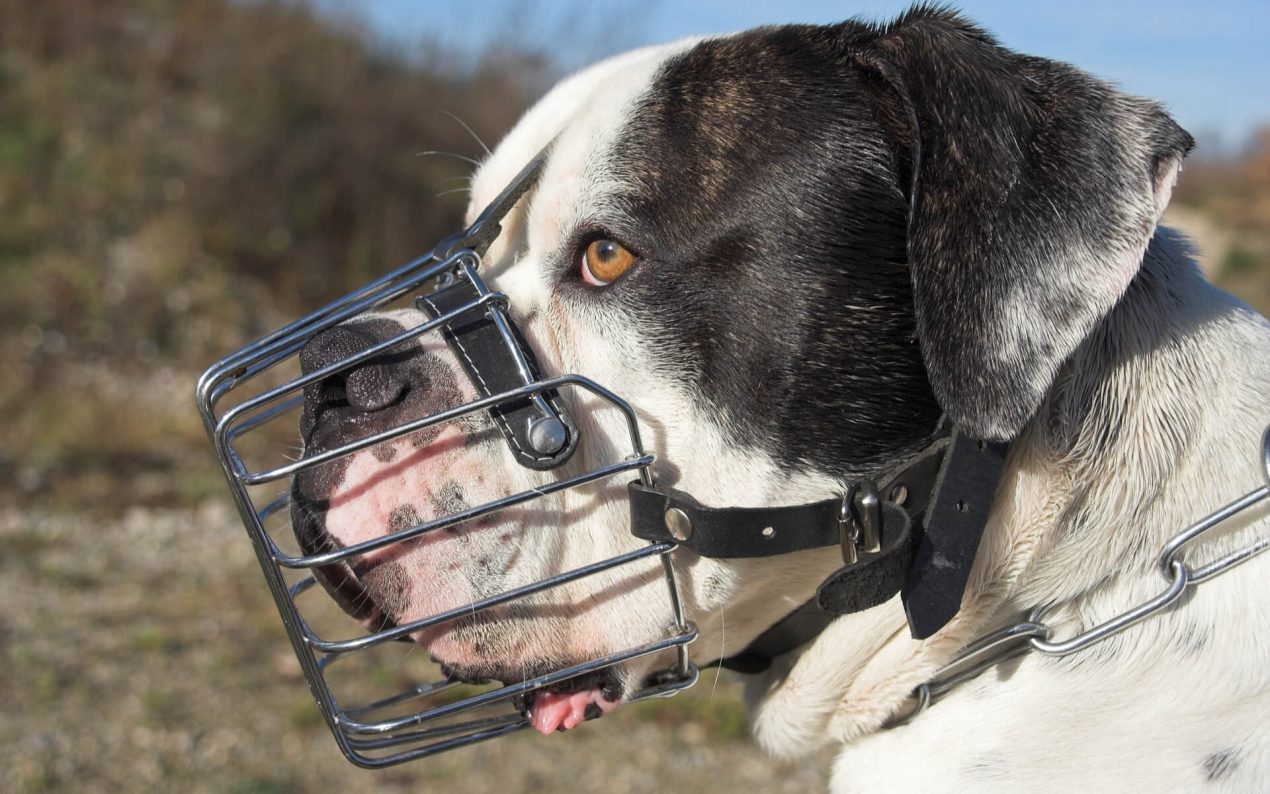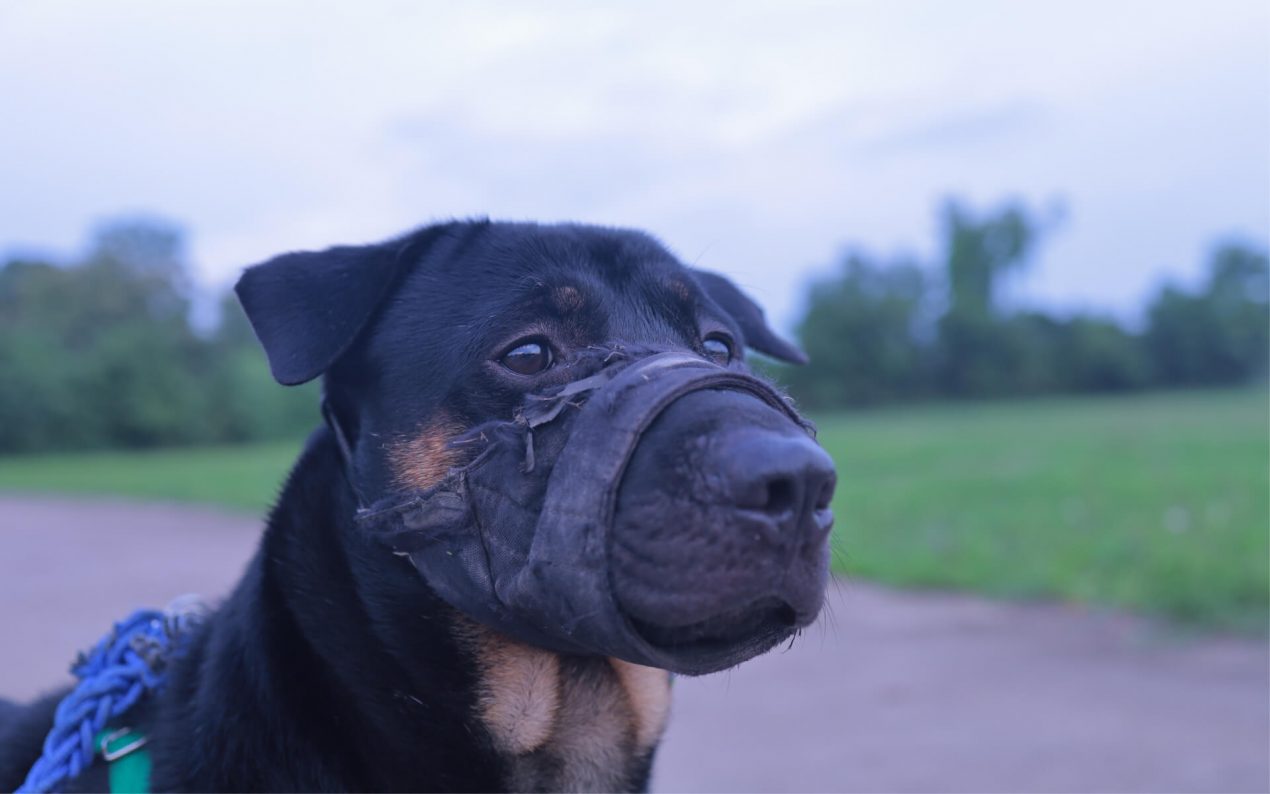Seeing a dog with a muzzle often prompts people to instinctively – and perhaps unconsciously – step back. Muzzled four-legged companions give off an aura of danger, aggression, and anything but cuteness.
However, this doesn’t have to be the case. Muzzles are by no means exclusive to malicious, combat-happy dogs. In many cases, they facilitate the coexistence and daily routines of both dog and owner, serving a purpose other than aggression or, quite simply, being legally required.
Muzzle for Dogs: Why, actually?
When does my dog need to wear a muzzle? There are various reasons why dogs wear muzzles. One of them is indeed the fact that the dog reacts aggressively and lunges forward when encountering fellow dogs. Besides crucial behavior training, a muzzle in this case can prevent other dogs – or humans – from getting injured. It also calms the dog owner, which translates to a positive influence on dog encounters.
On the other hand, some dogs reveal themselves as “vacuum cleaners” during daily walks – they eat anything edible (or what they think is edible) that comes in front of their snout. This behavior is not only dangerous for allergic individuals. Poisoned bait and razor blades hidden in soft foods are just examples of things that dog haters unfortunately increasingly place on popular walking routes. But feces and other items can also lead to diseases and parasite infestations. While working on a recall command with the dog, a muzzle can also be helpful in this case.
Some dogs, however well-behaved, may belong to a breed that is classified as dangerous (the so-called fighting dogs), and depending on the city, municipality, or state, there may be a mandatory muzzle requirement. This also applies to dogs that have previously exhibited aggressive behavior.
Then there are special situations in a dog’s life where, although a muzzle is not mandatory, it may be appropriate out of consideration for others. For example, in public transportation with many passengers, using a muzzle can provide a better feeling to fellow travelers. Also, at crowded festivals and other events where many people are in close proximity and there are no alternatives, a muzzle can help anxious individuals feel comfortable despite the immediate presence of a four-legged companion.
Finally, at the veterinarian’s office, even otherwise very friendly four-legged friends can quickly become grumpy – and snap at the person causing them pain at that very moment. To relieve the veterinarian and ensure their safety, a muzzle may also be necessary in this case.

When is a Muzzle Mandatory?
Is a muzzle mandatory? This question can be answered with a clear yes for some dogs. Muzzle requirements mainly affect dogs belonging to a breed listed as dangerous. This varies from state to state, but there are often significant differences even between individual cities. To make sure whether a muzzle must be worn, owners of such breeds should inform themselves precisely, especially before city trips, as well as during visits to zoos, camping vacations, and other occasions.
If the muzzle requirement is violated, whether out of ignorance or knowingly, serious penalties can be imposed. These range from more or less substantial fines to, in the worst case, the removal of the animal. However, there is a way to bypass the muzzle requirement. A so-called temperament test provides information about the behavior of the animal. If it is peaceful, the muzzle can be omitted with this certification. It can be obtained from many dog trainers and schools.
In many public transportation services, there is also a muzzle requirement, out of consideration for other passengers. An exception is made if the four-legged companion is in a suitable, appropriate transport box. Before a bus or train ride, the owner is therefore obliged to obtain information about the conditions under which the dog can be taken along.
Especially during longer journeys, many dog owners wonder: Can a dog sleep with a muzzle on? A short nap is certainly possible with a well-fitted muzzle – however, wearing it overnight can be very uncomfortable. Even with well-fitting muzzles, pressure sores can easily develop from lying down, and the muzzle may unpleasantly shift.
In some countries, such as France, there is also a muzzle requirement in public places and streets – often specifically for large animals above a certain body weight.
What to Consider with Dog Muzzles?
First and foremost, attention must be paid to the perfect fit when purchasing a muzzle. It should not press or rub anywhere. This causes pain when worn and can lead to chafed areas and even inflammation.
Which muzzle for which dog? This question is difficult to answer in a general sense. The muzzle must always fit the size, weight, and proportions of the animal. Trying it on before purchasing is not only helpful but indispensable. In case of doubt, a professional can also check whether the selected model really fits.
Very important: The four-legged companion must be able to open its mouth completely while wearing the muzzle! Especially in summer, otherwise, life-threatening overheating can occur, as the dog cannot perform its cooling strategy, panting.
Which muzzle is comfortable? Models made of soft leather are best, allowing the dog to pant, drink, and breathe freely. Although they still somewhat restrict the dog, regarding licking objects and smelling, they are much gentler than others.
Which is the best muzzle? Muzzles are best when the four-legged companion has been carefully accustomed to them and they hinder it as little as possible – both in contact with fellow dogs and in sniffing and seeing. Models made of hard materials or with metal grids should only be used if the dog has serious intentions of causing damage. However, even in this case, urgent work on the behavior of the four-legged friend is necessary to be able to free it from the protective device.
Which muzzle suits which dog?
Depending on the proportions and size of the dog, attention should be paid to the perfect fit of the muzzle. Often, the snout can be measured in advance to ensure that the owner finds the ideal model for their pet. Thus, models with long noses are more suitable for dogs than, for example, pugs or bulldogs with their very short snouts.
What qualifies as a muzzle? A muzzle is made of a solid material – this can be leather, plastic, or even metal. Basically, the harder the material, the greater the risk that other dogs will still be injured. This can happen through getting stuck, as well as through nudges and bumps with the nose. To ensure the well-being of the animal and to minimize the risk of injury to others, the material should always be chosen as soft as possible.
What is better: a muzzle strap or a muzzle? A muzzle allows better airflow and makes breathing easier for the dog. A muzzle strap, on the other hand, is placed tightly around the snout – drinking, panting, or normal breathing is made impossible. Can a dog bite with a muzzle strap? No, that is nearly impossible. Nevertheless, it is advisable to avoid such a strap as much as possible, as it significantly impairs the dog in its everyday life as well as in communication with fellow dogs.

How to Accustom Your Dog to a Muzzle
Is a muzzle bad for the dog? Yes – if it is not introduced gently and, above all, in a timely manner. A muzzle should never be worn for the first time in an already stressful situation. Otherwise, the four-legged companion quickly associates it with stress and unpleasant experiences, such as at the veterinarian’s office.
It is better to let him sniff it at home in peace. To positively associate the unfamiliar, unknown object, the dog can receive treats while getting to know it calmly. The first putting on and adjusting should always take place calmly and without tension.
Later, the muzzle can be worn in situations where the dog is relaxed and calm. Preferably in the comfort of one’s own home or in occasions that the four-legged friend associates with fun and action, such as during walks, running, and playing.
Do muzzles make dogs aggressive? If the muzzle is introduced calmly and without pressure, the four-legged companion is not more aggressive with it than without. However, if he senses the tension of the owner, the wearing of the muzzle was not gently introduced, and it is completely unfamiliar, the animal can actually react more roughly to fellow dogs out of uncertainty. It then feels impaired and cornered.
Ensure the muzzle is initially associated with positive experiences. Shower your dog with attention and rewards when wearing the muzzle, reinforcing positive behavior.


